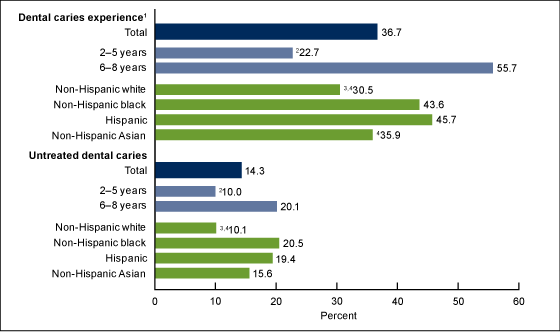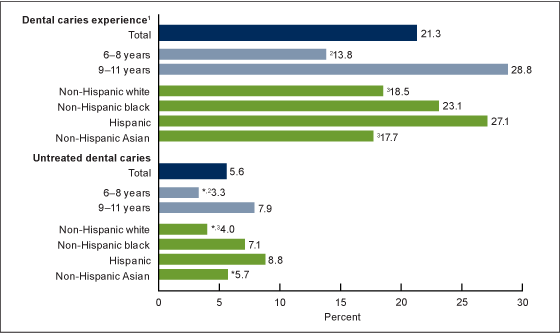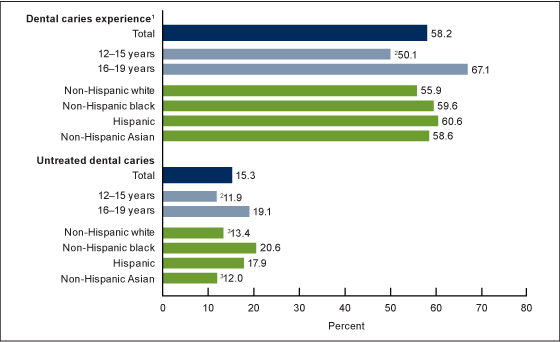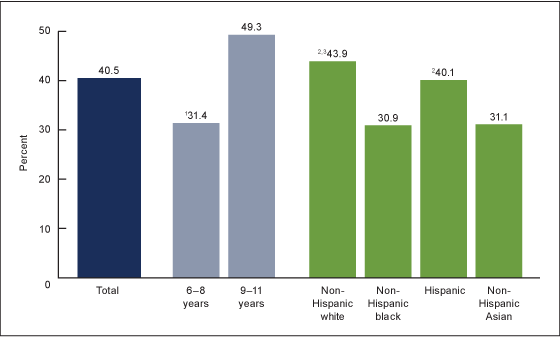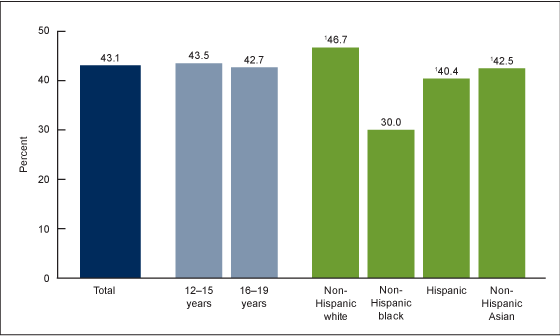Dental Caries and Sealant Prevalence in Children and Adolescents in the United States, 2011–2012
- Key findings
- How prevalent was any caries in children’s primary teeth?
- What percentage of children had any dental caries in permanent teeth?
- Among adolescents, how prevalent was dental caries in permanent teeth?
- How prevalent were dental sealants among children?
- Among adolescents, how prevalent were dental sealants?
- Summary
- Definitions
- Data source and methods
- About the authors
- References
- Suggested citation
NCHS Data Brief No. 191, March 2015
PDF Version (330 KB)
Bruce A. Dye, D.D.S., M.P.H.; Gina Thornton-Evans, D.D.S, M.P.H.; Xianfen Li, M.S.; and Timothy J. Iafolla, D.M.D., M.P.H.
Key findings
Data from the National Health and Nutrition Examination Survey, 2011–2012
- Approximately 23% of children aged 2–5 years had dental caries in primary teeth.
- Untreated tooth decay in primary teeth among children aged 2–8 was twice as high for Hispanic and non-Hispanic black children compared with non-Hispanic white children.
- Among those aged 6–11, 27% of Hispanic children had any dental caries in permanent teeth compared with nearly 18% of non-Hispanic white and Asian children.
- About three in five adolescents aged 12–19 had experienced dental caries in permanent teeth, and 15% had untreated tooth decay.
- Dental sealants were more prevalent for non-Hispanic white children (44%) compared with non-Hispanic black and Asian children (31% each) aged 6–11.
Although dental caries has been declining in permanent teeth for many children since the 1960s, previous findings showed caries in primary teeth for preschool children increasing from 24% to 28% between 1988 and 2004. Disparities in caries continue to persist for some race and ethnic groups in the United States. Prevalence of dental sealants—applied to the tooth chewing surfaces to help prevent caries—has also varied among sociodemographic groups (1–4). This report describes U.S. youth dental caries and sealant prevalence by race and Hispanic origin for 2011–2012.
Keywords: tooth decay, cavities, disparities, National Health and Nutrition Examination Survey
How prevalent was any caries in children’s primary teeth?
Approximately 37% of children aged 2–8 years had experienced dental caries in primary teeth in 2011–2012 (Figure 1). Dental caries among children aged 2–5 was nearly 23% compared with 56% among those aged 6–8. Caries prevalence was higher for Hispanic (46%) and non-Hispanic black (44%) children compared with non-Hispanic white children (31%) aged 2–8. Non-Hispanic Asian children were less likely to have experienced dental caries (36%) compared with Hispanic children (46%) aged 2–8, but were not different from non-Hispanic white or non-Hispanic black children.
In 2011–2012, 14% of children aged 2–8 had untreated tooth decay in primary teeth. Untreated caries in primary teeth was twice as high for children aged 6–8 (20%) compared with children aged 2–5 (10%). Tooth decay was significantly higher for both non-Hispanic black (21%) and Hispanic (19%) children compared with non-Hispanic white children aged 2–8 (10%). The prevalence of untreated dental caries in primary teeth in non-Hispanic Asian children did not significantly differ from that in any of the other race and Hispanic origin groups.
Figure 1. Prevalence of dental caries in primary teeth, by age and race and Hispanic origin among children aged 2–8 years: United States, 2011–2012
1Includes untreated and treated (restored) dental caries.
2Significantly different from those aged 6–8 years, p < 0.05.
3Significantly different from non-Hispanic black children, p < 0.05.
4Significantly different from Hispanic children, p < 0.05.
NOTE: Access data table for Figure 1 [PDF – 86KB].
SOURCE: CDC/NCHS, National Health and Nutrition Examination Survey, 2011–2012.
What percentage of children had any dental caries in permanent teeth?
In 2011–2012, 21% of children aged 6–11 had experienced dental caries in permanent teeth (Figure 2). Dental caries among children aged 6–8 was nearly 14% and was twice as high for children aged 9–11 (29%). Caries prevalence was higher among Hispanic children aged 6–11 (27%) compared with non-Hispanic white children (19%) or non-Hispanic Asian children (18%).
Approximately 6% of children aged 6–11 had untreated tooth decay in permanent teeth. Untreated caries in permanent teeth was twice as high for children aged 9–11 (8%) compared with children aged 6–8 years (3%). Prevalence of untreated caries was higher for Hispanic children (9%) compared with non-Hispanic white children (4%) aged 6–11 years.
Figure 2. Prevalence of dental caries in permanent teeth, by age and race and Hispanic origin among children aged 6–11 years: United States, 2011–2012
* Does not meet standards of statistical reliability and precision (relative standard error of ≥ 30% but < 40%).
1Includes untreated and treated (restored) dental caries.
2Significantly different from those aged 9–11 years, p < 0.05.
3Significantly different from Hispanic children, p < 0.05.
NOTE: Access data table for Figure 2 [PDF – 86KB].
SOURCE: CDC/NCHS, National Health and Nutrition Examination Survey, 2011–2012.
Among adolescents, how prevalent was dental caries in permanent teeth?
Among adolescents aged 12–19, 58% had experienced dental caries in permanent teeth in 2011–2012 (Figure 3). The prevalence of dental caries experience was higher among adolescents aged 16–19 (67%) compared with those aged 12–15 (50%). Overall, the percentage with caries experience did not significantly differ by race and Hispanic origin among adolescents.
Fifteen percent of adolescents aged 12–19 had untreated caries in permanent teeth in 2011–2012. Untreated tooth decay was higher among adolescents aged 16–19 (19%) compared with those aged 12–15 (12%). Untreated caries was higher for non-Hispanic black adolescents (21%) compared with non-Hispanic white (13%) or non-Hispanic Asian (12%) adolescents.
Figure 3. Prevalence of dental caries in permanent teeth, by age and race and Hispanic origin among adolescents aged 12–19 years: United States, 2011–2012
1Includes untreated and treated (restored) dental caries.
2Significantly different from those aged 16–19 years, p < 0.05.
3Significantly different from non-Hispanic black adolescents, p < 0.05.
NOTE: Access data table for Figure 3 [PDF – 86KB].
SOURCE: CDC/NCHS, National Health and Nutrition Examination Survey, 2011–2012.
How prevalent were dental sealants among children?
Nearly one-half of children aged 9–11 had at least one dental sealant on a permanent tooth, whereas 31% of children aged 6–8 had a dental sealant (Figure 4). Non-Hispanic black and non-Hispanic Asian children aged 6–11 (31%) had lower dental sealant prevalence compared with non-Hispanic white children (44%). Hispanic children (40%) had higher dental sealant prevalence compared with non-Hispanic black children aged 6–11 (31%).
Figure 4. Prevalence of dental sealants in permanent teeth, by age and race and Hispanic origin among children aged 6–11 years: United States, 2011–2012
1Significantly different from those aged 9–11 years, p < 0.05.
2Significantly different from non-Hispanic black children, p < 0.05.
3Significantly different from non-Hispanic Asian children, p < 0.05.
NOTE: Access data table for Figure 4 [PDF – 86KB].
SOURCE: CDC/NCHS, National Health and Nutrition Examination Survey, 2011–2012.
Among adolescents, how prevalent were dental sealants?
In 2011–2012, 43% of adolescents aged 12–19 had at least one permanent tooth with a dental sealant (Figure 5). Dental sealant prevalence was similar among both adolescent age groups (43%). Dental sealant prevalence was significantly lower for non-Hispanic black adolescents (30%) compared with non-Hispanic white (47%), Hispanic (40%), or non-Hispanic Asian (43%) adolescents aged 12–19.
Figure 5. Prevalence of dental sealants in permanent teeth, by age and race and Hispanic origin among adolescents aged 12–19 years: United States, 2011–2012
1Significantly different from non-Hispanic black adolescents, p < 0.05.
NOTE: Access data table for Figure 5 [PDF – 86KB].
SOURCE: CDC/NCHS, National Health and Nutrition Examination Survey, 2011–2012.
Summary
Overall, disparities persisted in the United States for dental caries and dental sealant prevalence in children and adolescents in 2011–2012. In children aged 2–8, Hispanic and non-Hispanic black children were more likely to experience any dental caries in primary teeth compared with non-Hispanic white children. Non-Hispanic Asian children were less likely to have experienced dental caries in primary teeth compared with Hispanic children aged 2–8. Untreated tooth decay was nearly twice as high in Hispanic and non-Hispanic black children aged 2–8 compared with non-Hispanic white children. Among all children aged 2–5, 23% had experienced dental caries.
In children aged 6–11, one in five children had experienced dental caries in their permanent teeth, and approximately 40% had at least one dental sealant present. The prevalence of dental caries was higher in Hispanic children compared with non-Hispanic white children or non-Hispanic Asian children. Among children aged 6–11, non-Hispanic black and non-Hispanic Asian children were less likely to have dental sealants compared with non-Hispanic white children. Hispanic children were more likely to have at least one dental sealant on a permanent tooth compared with non-Hispanic black children aged 6–11.
Among adolescents aged 12–19, nearly three in five adolescents had experienced dental caries in permanent teeth, 15% had untreated tooth decay, and 43% had at least one dental sealant present. Dental caries experience was not significantly different among Hispanic and non-Hispanic white, black, and Asian adolescents. Among adolescents, the prevalence of untreated tooth decay was significantly higher in non-Hispanic black adolescents compared with non-Hispanic white or non-Hispanic Asian adolescents. Dental sealant prevalence was significantly lower for non-Hispanic black adolescents compared with Hispanic, non-Hispanic white, and Asian adolescents.
Definitions
Untreated dental caries: Dental cavities (tooth decay) that have not received appropriate treatment.
Dental caries: Having a tooth appropriately treated for tooth decay or having untreated decay present.
Dental sealants: Plastic-like coatings that are applied to the chewing surfaces of back teeth. The applied sealant resin bonds into the grooves of teeth to form a protective physical barrier.
Data source and methods
The National Health and Nutrition Examination Survey (NHANES) is a cross-sectional survey designed to monitor the health and nutritional status of the civilian noninstitutionalized U.S. population. Survey participants are selected through a complex, multistage process, which includes oversampling to obtain reliable estimates of health and nutritional measures for population subgroups. In 2011–2012, oversampling included Hispanic, non-Hispanic black, and Asian persons. The survey consists of interviews conducted in participants’ homes and standardized physical examinations in mobile examination centers (MECs). Visit the NHANES website for additional information.
From 2011 through 2012, the NHANES oral health assessment was conducted in MECs by trained dentists. The assessment included a tooth count to identify the presence or absence of permanent or primary teeth, including retained dental root tips and dental implants. Each tooth was assessed for dental caries, restorations, and sealants. Dental exams were conducted using a dental light for illumination, a dental mirror, and an explorer. Overall, preliminary data reliability analyses conducted for 2011–2012 indicate that examiner performance was similar to prior survey periods using the same dental caries examination methods (1999–2004).
Population estimates and standard errors were calculated in SAS-callable SUDAAN software (release 11.0; RTI International, Research Triangle Park, N.C). To account for differing probabilities of selection, nonresponse, and noncoverage, exam sample weights were used for analysis. The standard errors of the percentages were estimated using Taylor series linearization, to take into account the complex sampling design. Differences between groups were evaluated using a t statistic at the p < 0.05 significance level. All results presented have a relative standard error less than 30% or are marked as ≤ 40% on the figures. All differences discussed are statistically significant unless otherwise indicated. Calculated estimates were not age-adjusted and no adjustments were made for multiple comparisons.
About the authors
Bruce A. Dye is with NIH’s National Institute of Dental and Craniofacial Research. Gina Thornton-Evans is with CDC’s National Center for Chronic Disease Prevention and Health Promotion, Division of Oral Health. Xianfen Li is with CDC’s National Center for Health Statistics, Office of Analysis and Epidemiology. Timothy J. Iafolla is with NIH’s National Institute of Dental and Craniofacial Research.
References
- Dye BA, Arevalo O, Vargas CM. Trends in paediatric caries by poverty status in the United States, 1988–1994 and 1999–2004. Int J Paediatr Dent 20(2):132–43. 2010.
- Dye BA, Tan S, Smith V, et al. Trends in oral health status: United States, 1988–1994 and 1999–2004. National Center for Health Statistics. Vital Health Stat 11(248). 2007.
- Dye BA, Li X, Beltrán-Aguilar ED. Selected oral health indicators in the United States, 2005–2008. NCHS data brief, no 96. Hyattsville, MD: National Center for Health Statistics. 2012.
- Dye BA, Li X, Thornton-Evans G. Oral health disparities as determined by selected Healthy People 2020 oral health objectives for the United States, 2009–2010. NCHS data brief, no 104. Hyattsville, MD: National Center for Health Statistics. 2012.
Suggested citation
Dye BA, Thornton-Evans G, Li X, Iafolla TJ. Dental caries and sealant prevalence in children and adolescents in the United States, 2011–2012. NCHS data brief, no 191. Hyattsville, MD: National Center for Health Statistics. 2015.
Copyright information
All material appearing in this report is in the public domain and may be reproduced or copied without permission; citation as to source, however, is appreciated.
National Center for Health Statistics
Charles J. Rothwell, M.S., M.B.A., Director
Nathaniel Schenker, Ph.D., Deputy Director
Jennifer H. Madans, Ph.D., Associate Director for Science
Division of Health and Nutrition Examination Surveys
Kathryn S. Porter, M.D., M.S., Director
